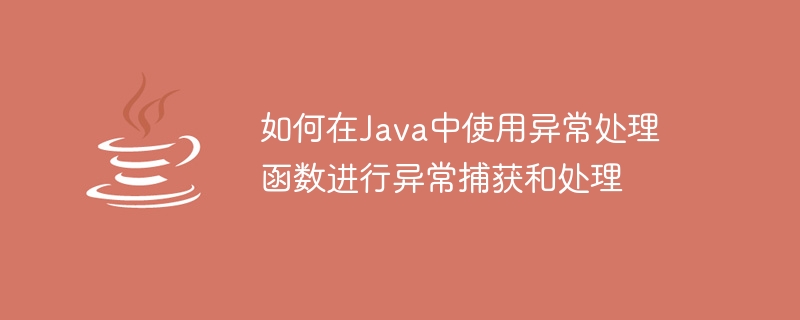

How to use exception handling functions for exception catching and handling in Java
In Java programming, exception handling is an important technology that allows the program to run Detect and handle errors that occur during the process to ensure the stability and reliability of the program. The core concepts of exception handling in Java are exceptions and exception handling functions.
1. Exceptions
Exceptions refer to errors or abnormal situations that occur during program running. Exceptions in Java can be divided into two types: Checked Exception and Unchecked Exception.
Checked exceptions refer to exceptions that need to be handled or thrown during the compilation phase, such as IOException, SQLException, etc. If a checked exception is not handled or thrown, the compiler will report an error.
Unchecked exceptions refer to exceptions that occur during runtime, such as NullPointerExceptoin, ArrayIndexOutOfBoundsException, etc. Unchecked exceptions do not require mandatory handling, but handling is recommended to ensure program robustness.
2. Exception handling function
In Java, you can use try-catch blocks to handle exceptions. The try block is used to contain code that may cause an exception, and the catch block is used to catch and handle exceptions.
The syntax of try-catch block is as follows:
try {
// 可能产生异常的代码
} catch (ExceptionType1 e1) {
// 处理ExceptionType1类型的异常
} catch (ExceptionType2 e2) {
// 处理ExceptionType2类型的异常
} catch (ExceptionType3 e3) {
// 处理ExceptionType3类型的异常
} finally {
// 可选:无论是否有异常发生,都会执行的代码
}
Write code that may cause exceptions in the try block, When an exception occurs, the program will jump to the corresponding catch block. The parameters in the catch block are variables used to receive exception objects. Through this variable, the type and detailed information of the exception can be obtained and processed accordingly. The finally block is optional and the code in it will be executed regardless of whether an exception occurs.
3. Example of using the exception handling function
The following uses a specific example to show how to use the exception handling function to capture and handle exceptions.
Suppose there is a function for calculating the quotient of two integers:
public static int divide(int dividend, int divisor) {
return dividend / divisor;
}
When divisor is 0, an ArithmeticException will be thrown. In order to prevent the program from crashing, we can use exception handling functions to catch and handle exceptions.
public static void main(String[] args) {
int dividend = 10;
int divisor = 0;
try {
int result = divide(dividend, divisor);
System.out.println("结果:" + result);
} catch (ArithmeticException e) {
System.out.println("除零异常:" + e.getMessage());
}}
In the main function, we call the divide function and put the code that may generate exceptions in try block. When a divide-by-zero exception occurs, it jumps to the catch block and prints the exception information.
Summary:
In Java, using exception handling functions can effectively capture and handle exceptions to ensure the stability and reliability of the program. Through the try-catch block, you can separate the code that may cause exceptions from the code that handles exceptions, making the program structure clearer. However, when using exception handling functions, you need to pay attention to the type and handling method of exceptions to avoid catching overly broad exceptions or ignoring exception handling, which may cause more serious problems.
The above is the detailed content of How to use exception handling functions for exception catching and handling in Java. For more information, please follow other related articles on the PHP Chinese website!




